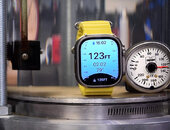alex-vasenin
New
Even though Apple Watch Ultra rated as 100m water resistant its depth sensor seems to be limited to 40 meters, as Apple say:
I wonder, what exactly would happen with Oceanic+ app if one go below 40 meters? Did anyone try it already?
Your Apple Watch Ultra is designed to comply with EN13319. The Depth app works to a maximum depth of 130 feet (40 meters). If you go below this depth, the screen turns yellow, and some functions of your Apple Watch Ultra might stop working or might work intermittently. The depth sensor on Apple Watch Ultra is accurate to plus or minus 1 meter.
Apple Watch Ultra and its depth sensor are compatible with third-party apps that can serve as a dive computer for recreational scuba diving to 130 feet (40 meters).
I wonder, what exactly would happen with Oceanic+ app if one go below 40 meters? Did anyone try it already?





